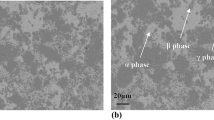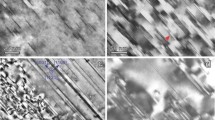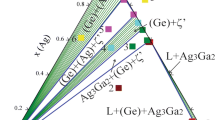Abstract
Gravimetric measurements at low temperatures (<600°C) and for dilute Ag-Mg alloys have given further information about the mechanism of oxide formation. This investigation shows that the fixation rate of oxygen is very high, which assumes the existence of species in an oxidized form, including one or two magnesium atoms called “elementary species” and denoted as MgO* and Mg2O*. When there are no free magnesium atoms, there is a coalescence process with the fixation of oxygen atoms or MgO* and Mg2O*: this process leads to the formation of the first “clusters” including an oxygen excess. At low temperatures, the thermal fluctuations do not permit significant changes. There is no significant increase in cluster size, but a rearrangement of these clusters toward a compact structure with the release of excess oxygen. Their size is less than 1 nm.
Similar content being viewed by others
References
J. L. Meijering and M. J. Druyvesteyn,Philips Res. Rep. 2, 81 (1947).
M. J. Klein and R. A. Huggins,Acta Met. 10, 55 (1962).
A. Combe, L. Charrin, G. Moya, and J. Cabane,Acta Met. 31(7), 1019 (1983).
L. Charrin, A. Combe, and G. Moya,J. Therm. Anal. 14, 89 (1978).
L. Charrin, A. Combe, and G. Moya,Acta Met. 29, 1593 (1981).
A. Charai, A. Combe, C. Boulesteix, and J. Cabane,Scripta Met. 17, 833 (1983).
A. Charai and G. Nihoul,Phil. Mag. A 58(4), 571 (1988).
A. Combe and J. Cabane,Oxid. Met. 21(1–2), 21 (1984).
S. Guruswamy, S. M. Park, J. P. Hirth, and R. A. Rapp,Oxid. Met. 26(1–2), 77 (1986).
L. D. Pethe, H. B. Mathur, and A. B. Biswas,Can. J. Chem. 46, 1187 (1968).
C. Wagner,Z. Elektrochem. 63, 772 (1959).
C. Wagner,Z. Elektrochem. 65, 581 (1961).
L. S. Darken,Trans. Am. Soc. Met. 54, 600 (1961).
F. N. Rhines, W. A. Johnson, and W. A. Anderson,Trans. AIME 147, 205 (1942).
R. A. Rapp,Corrosion 21, 382 (1965).
J. E. Verfurth and R. A. Rapp,Trans. Met. Soc. AIME 230, 1310 (1964).
W. Eichenauer and G. Muller,Z. Metall. 53, 321, 700 (1962).
A. F. Pasquevich, F. H. Sanchez, A. G. Bibiloni, J. Desimoni, and A. Lopez-Garcia,Phys. Rev. B 27, 2 (1982).
J. Desimoni, A. G. Bibiloni-Zelis, A. F. Pasquevich, F. H. Sanchez, and A. Lopez-Garcia,Phys. Rev. B 28, 10 (1983).
F. H. Sanchez, R. C. Mercader, A. F. Pasquevich, A. G. Bibiloni, and A. Lopez-Garcia,Mater. Res. Soc. Symp. Proc. 48, 455 (1985).
Author information
Authors and Affiliations
Rights and permissions
About this article
Cite this article
Charrin, L., Combe, A. & Cabane, J. Oxide particles in Ag-Mg alloys formed by internal oxidation. Oxid Met 37, 65–80 (1992). https://doi.org/10.1007/BF00665631
Received:
Revised:
Issue Date:
DOI: https://doi.org/10.1007/BF00665631




